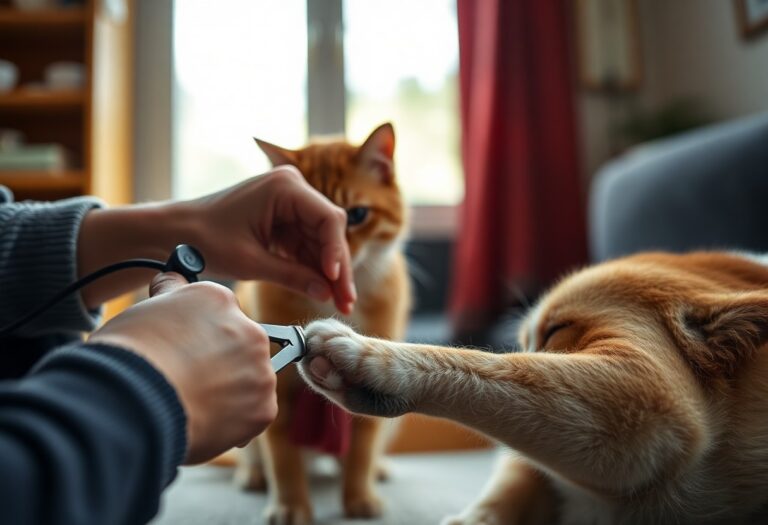Pets are vulnerable to the harsh conditions that cold weather brings, which can lead to serious health issues if not properly managed. To ensure your furry companions remain safe and warm, it’s vital to take precautions such as providing adequate shelter, monitoring their outdoor time, and adjusting their diets. Simple measures like dressing your pet in a coat for walks and ensuring they have access to fresh water can make a significant difference. With the right steps, you can help your pets enjoy the winter season comfortably and safely.
AI-Powered Innovations in Pet Winter Gear
High-Tech Solutions for Keeping Pets Warm
Advanced technology has transformed the pet gear industry, leading to innovative solutions that provide warmth and comfort to your furry companions during harsh winter months. Smart heated pet jackets equipped with temperature sensors, for example, automatically adjust their heating levels based on your pet’s body temperature and the surrounding environment. These jackets often feature lightweight materials to ensure your pet doesn’t feel weighed down while still providing adequate insulation against the cold. Furthermore, the integration of reflective materials enhances visibility, keeping your pet safe on evening walks.
Another remarkable innovation includes smart collars that not only keep track of your pet’s location but also monitor their activity levels and body temperature. Some of these collars can send alerts directly to your smartphone if they detect a significant drop in your pet’s warmth, prompting you to bring your pet inside or provide additional blankets. With these high-tech options, you can embrace the winter months knowing your pet is well-protected and comfortable no matter how low the temperatures drop.
Assessing Effectiveness: Are They Worth the Investment?
Investing in AI-powered winter gear may seem steep initially, with prices ranging from $50 to over $200 depending on the complexity of the product. However, weighing the potential long-term benefits against the upfront cost reveals that such innovations can save you from unexpected vet bills and provide peace of mind during chilly outings. For instance, a well-insulated jacket that adjusts its warmth according to your pet’s needs can prevent hypothermia, an illness that could unravel considerable expenses and emotional distress. Moreover, these high-tech items often boast durability, ensuring you won’t have to replace them frequently, which can make them more cost-effective over time.
Holistic assessments of these pet winter gear innovations showcase their merit. Many pet owners find that not only do these products enhance their pets’ comfort, but they also come equipped with features that make monitoring your pet’s health easier. Advanced sensors and connectivity allow for seamless checks on their well-being. Ultimately, the decision hinges on your pet’s specific needs, your regional climate, and how often your furry friends are exposed to the elements. Investing in AI-powered winter gear could be a thoughtful decision that supports your pet’s health while enhancing the bond you share as you navigate winter together.
Identifying Cold-Weather Hazards for Pets
Common Risks in Winter: Ice, Snow, and Toxic Substances
During winter months, your pet can face various hazards that are often overlooked. Ice and snow can pose significant risks, creating slippery surfaces that may lead to injuries such as sprains or fractures if your pet slips. Additionally, the accumulation of snow can obscure hazardous objects, such as sharp stones or metal debris, which your furry friend may not see. Moreover, while your pet might seem interested in playing in the snow, it’s vital to monitor their behavior closely, as they can easily ingest snow or ice that may be contaminated with toxic substances.
Many pet owners inadvertently expose their animals to toxic de-icing agents and antifreeze, both common hazards in colder months. Common de-icers contain chemicals like sodium chloride, which can cause gastrointestinal distress if ingested. Antifreeze, often used in vehicle maintenance, has a sweet taste that attracts pets but can lead to severe poisoning. Taking steps to limit your pet’s access to these substances and being vigilant about washing their paws following outdoor excursions significantly reduces the likelihood of an incident.
Behavioral Changes in Pets During Cold Weather
As temperatures drop, you might notice shifts in your pet’s behavior that indicate they are feeling the chill. Many dogs and cats may become less active, preferring to curl up in warm spots rather than engage in play. This newfound lethargy isn’t just about finding a cozy place; it can be a form of self-preservation, as they instinctively seek warmth. If your dog is reluctant to go outside or resists walks, it may be their way of expressing discomfort with the cold weather.
Another common behavioral change involves changes in eating habits. Some pets may eat more during winter months, potentially due to an increased metabolic demand for warmth, while others might eat less, depending on how they react to their environment. Additionally, altered bathroom habits can occur, with some pets delaying their potty needs due to cold surfaces. Understanding these behavior changes will help you meet your pet’s needs more effectively during this chilly time of year.
Practical Tips for Winter Pet Care
Keeping your pets safe during the winter months requires a proactive approach. You can take several simple steps to ensure their well-being despite the biting cold. Regularly check weather conditions before walking your pet; if temperatures drop too low, consider adjusting your routine accordingly. Providing a warm layer such as a pet coat or booties can help minimize the risk of frostbite on their paws. Always monitor your pets closely when outdoors and watch for signs of discomfort, such as excessive shivering or reluctance to walk.
- Limit outdoor time in severe cold
- Invest in a high-quality pet coat
- Use booties to protect paw pads
- Ensure your pet has access to fresh water at all times
- Provide a warm indoor retreat for rest
Knowing how to adapt to winter conditions can significantly enhance your pet’s health and happiness throughout the colder months.
Essential Accessories for Outdoor Safety
Equipping your pet with the right accessories during winter not only enhances safety but also ensures enjoyment of their outdoor experience. A custom-fit pet coat can shield them from icy winds and low temperatures, while paw wax serves as a protective layer against salt and ice. Look for high-visibility leashes and collars, which make your pet easier to spot in dim lighting and snowy conditions. Each accessory adds an extra layer of security, allowing them to explore safely.
Consider reflective gear that boosts their visibility during those shorter daylight hours. You might also want to get a GPS tracking collar for peace of mind. Should your pet wander off in the snow, having a way to track them can be invaluable, especially given how easily they can become disoriented in unfamiliar surroundings. This combination of preparation and the right gear can ensure your pet has fun without compromising safety.
Indoor Comfort: Creating a Warm Retreat
While outdoor safety is important, don’t forget about your pet’s comfort inside the home during the winter. Create a warm, cozy retreat where your pet can feel safe and relaxed. Choose a quiet spot away from drafts, and consider adding blankets or a heated pet bed to provide extra warmth. Cats, in particular, love snuggling up in soft spaces, so a comfortable area can act as their own personal sanctuary. Avoid placing their bed directly on cold surfaces, as this may retain chill.
Monitor indoor temperatures to ensure a comfortable environment, especially if you use heating systems that might dry out the air. Pets are susceptible to changes in humidity, necessitating the need for a humidifier during harsh winter months. Providing soft toys and familiar objects can also make their space feel more inviting, helping to ease any anxiety caused by cold weather changes.
Establishing a designated warm area adds routine and comfort to your pet’s lifestyle. This environment not only fosters a heightened sense of security but also encourages relaxation during long winter nights. Incorporating padded bedding and engaging toys creates an inviting atmosphere that helps mitigate any stress associated with the seasonal change, reinforcing your pet’s well-being as they navigate through winter’s chill.
The Role of Diet and Hydration in Cold Weather
Adjusting Pet Diets for Seasonal Needs
Cold weather can lead to increased energy expenditure in pets, necessitating a review of their diets. Many pets are more active during winter months, whether by playful behavior in the snow or simply by trying to keep warm. This increased output can translate to a higher caloric requirement. As temperatures drop, consider increasing the portion sizes or even switching to a high-quality dog food that contains more protein and fat to help maintain their body temperature and energy levels. Additionally, feeding frequency can also be adjusted; some pet owners find that offering smaller, more frequent meals helps sustain energy throughout the day.
Also, special attention should be paid to pets that are indoor sedentary versus those that remain active outside. Indoor pets may not require as many calories, but it’s imperative to evaluate their overall health and weight. Weight management plays a vital role during the colder months to ensure that your pets remain healthy and fit. Consult your veterinarian for tailored dietary adjustments according to your pet’s specific needs for wintertime activity levels.
Ensuring Access to Water in Freezing Temperatures
Hydration should never take a back seat, even in winter. By offering access to freshwater, you can help ward off dehydration, which can be just as dangerous in cold weather as in the heat. Water can freeze quickly in cold temperatures, particularly if you and your pets spend a lot of time outdoors. It’s advisable to check your pet’s water bowl frequently, replacing frozen water regularly to keep them hydrated. To help prevent freezing, consider using heated water bowls designed specifically for pets, ensuring they always have a reliable source of fresh water.
Additionally, keeping your pet indoors for extended periods can lead to decreased water intake, as they might not feel thirsty. Even if they seem less active, offering smaller amounts of water more frequently can encourage drinking. If your dog seems reluctant to drink, try enticing them with ice cubes or adding flavor to their water, making it more appealing and enjoyable.
| Use heated water bowls | Prevents freezing and ensures fresh water is always accessible |
| Check water bowls frequently | Replace any frozen water to encourage regular drinking |
| Offer ice cubes as a treat | Increases water intake while adding an element of fun |
In addition to monitoring water intake, being cognizant of how you set up your pet’s environment can make a significant difference in their hydration levels. If your pets spend a lot of time outside during the winter, consider placing multiple water stations in shaded or sunny areas to prevent freezing. If you notice your pet is not drinking as much as they should, supplementing their diet with wet or canned food can be another practical solution. These types of food usually contain a higher moisture content, contributing to their overall hydration status, helping keep your furry friend healthy and comfortable even in the coldest weather.
| Incorporate wet food | Provides extra moisture while also being nutritious |
| Install a pet water fountain | Encourages drinking through moving water, often more enticing than still water |
| 季節に合ったフレーバーを追加 | さまざまな健康的なフレーバーを加えて飲水を楽しいものにします |
Signs of Cold-Weather Distress in Pets
Recognizing Hypothermia and Frostbite Symptoms
Pets can become vulnerable to hypothermia and frostbite when exposed to extreme cold for prolonged periods. Symptoms of hypothermia often manifest as shivering, lethargy, and a noticeable decrease in activity levels. You may also observe your pet seeking warmth, such as curling up in a tight ball or trying to burrow into blankets or other surfaces. In severe cases, a pet may become unresponsive and exhibit a slow heartbeat. Frostbite, on the other hand, usually affects the extremities—paws, ears, and tail. Look for signs like pale or bluish skin, swelling, or changes in texture where skin appears blackened or hardened.
It’s vital to act quickly if you notice these symptoms. Your pet may be showing less obvious signs of distress, such as reluctance to walk or difficulty moving, which could indicate hidden issues that can escalate. You could differentiate between discomfort and severe cold-related distress by being attuned to any sudden behavioral changes. Keep a close eye on your furry friends during outings in cold weather consistently.
Immediate Actions to Take in an Emergency
If you suspect your pet is experiencing hypothermia or frostbite, taking immediate action is crucial. Move your pet to a warm environment as soon as possible, preferably indoors. Gently wrap them in warm blankets or towels, avoiding hot water as it can shock their system. Check for signs of frostbite and, if possible, try to warm the affected area gradually using your body heat or a warm (not hot) water bottle. If symptoms persist beyond initial warmth or your pet shows signs of severe distress, contact your veterinarian immediately.
Providing a safe and warm space for your pet is critical in these situations. Monitor their condition closely, as animals under stress may not express discomfort vocally. You may want to take their temperature; a normal reading should be between 100°F and 102.5°F. Keep various sources of warmth nearby should your pet require additional heat. In an emergency, every moment counts, so be proactive in seeking professional help when faced with a potentially life-threatening situation.
Conclusion
As a reminder, keeping your pets safe during cold weather involves taking proactive steps to ensure their health and well-being. This means providing them with proper shelter, ensuring their food and water are not freezing, and limiting their time outdoors when temperatures plummet. You should always monitor their behavior for signs of distress and be vigilant about their physical condition, as pets can be more susceptible to cold weather challenges than you might realize. Investing in pet-specific clothing or accessories can also make a significant difference in maintaining their comfort outdoors.
Additionally, this time of year is an excellent opportunity to reevaluate your pet’s living environment, ensuring that they have a warm and cozy space to retreat to when the temperatures drop. You may also want to check your home for potential hazards associated with the winter season, such as antifreeze or harmful snow and ice removal products. Your diligence in protecting your pets will not only keep them comfortable but also help foster a strong bond between you and your furry companions as you navigate the colder months together.







